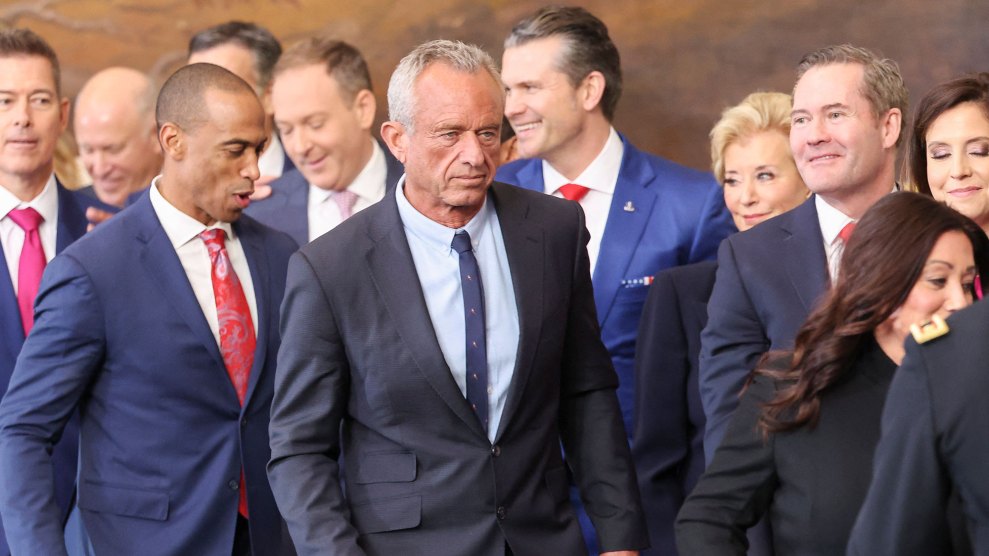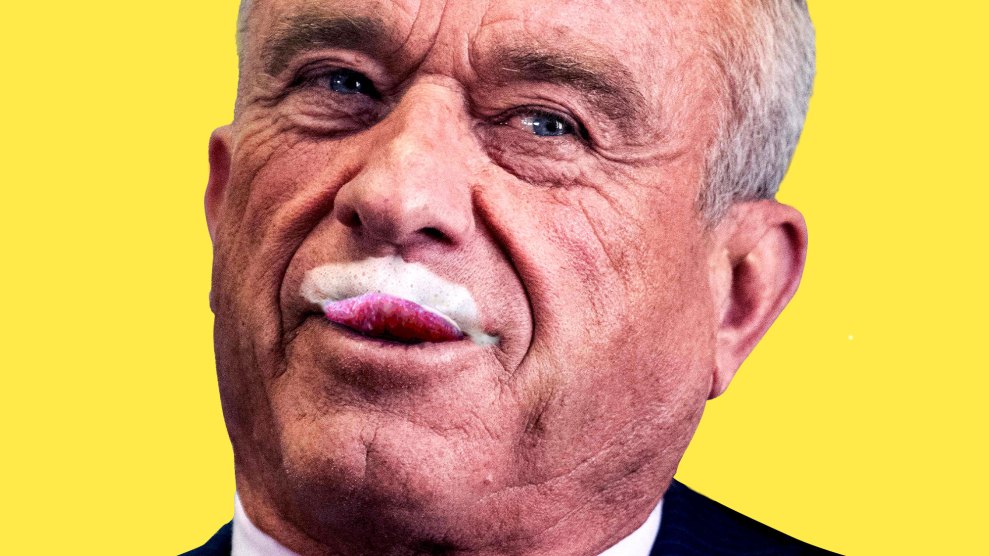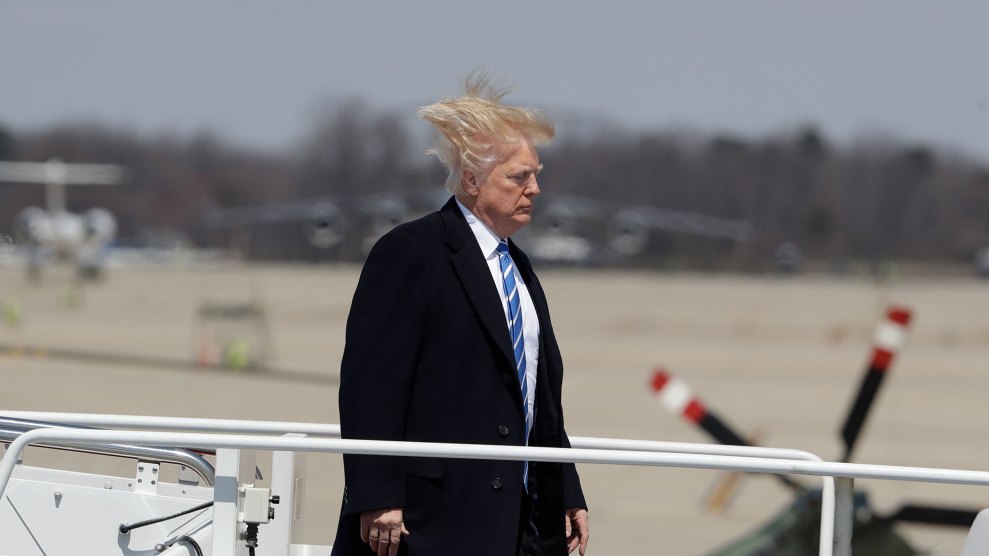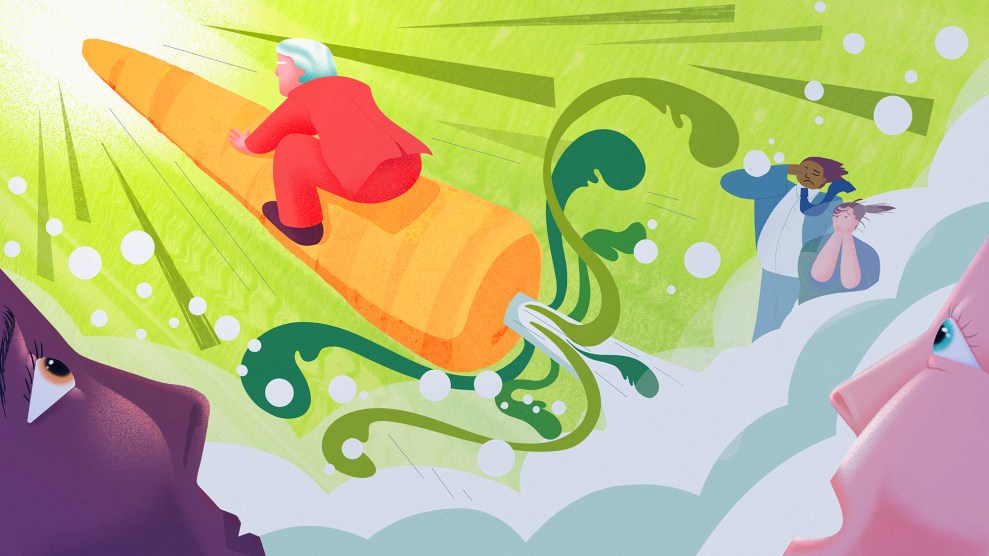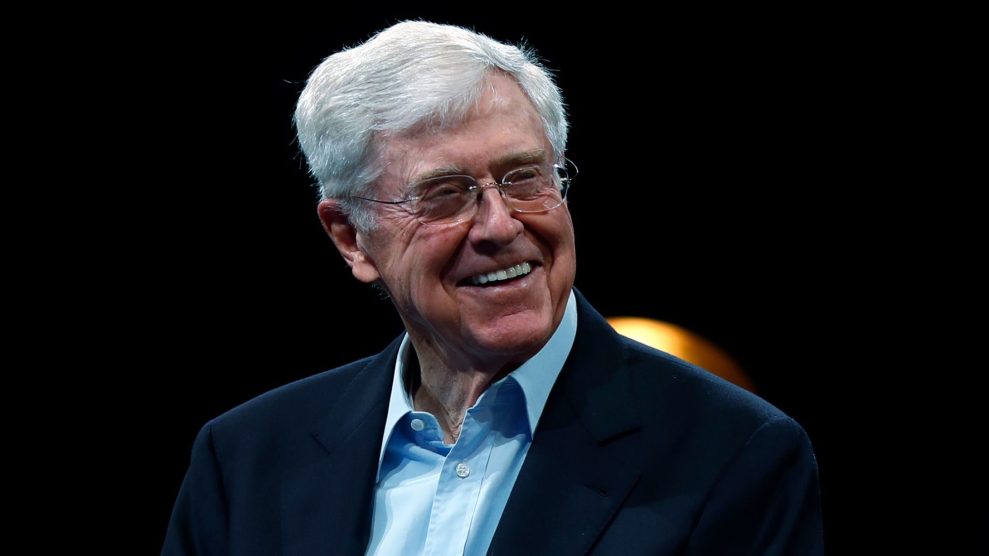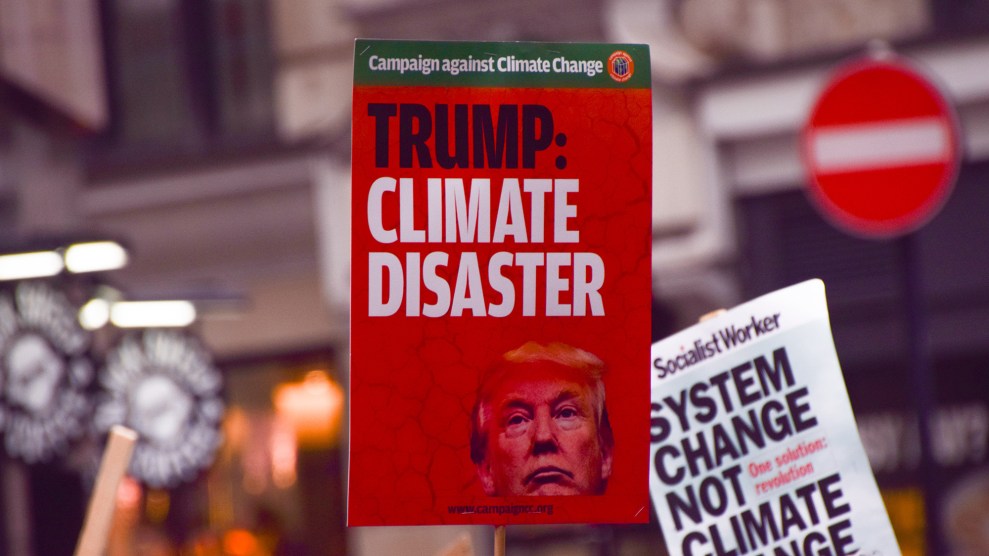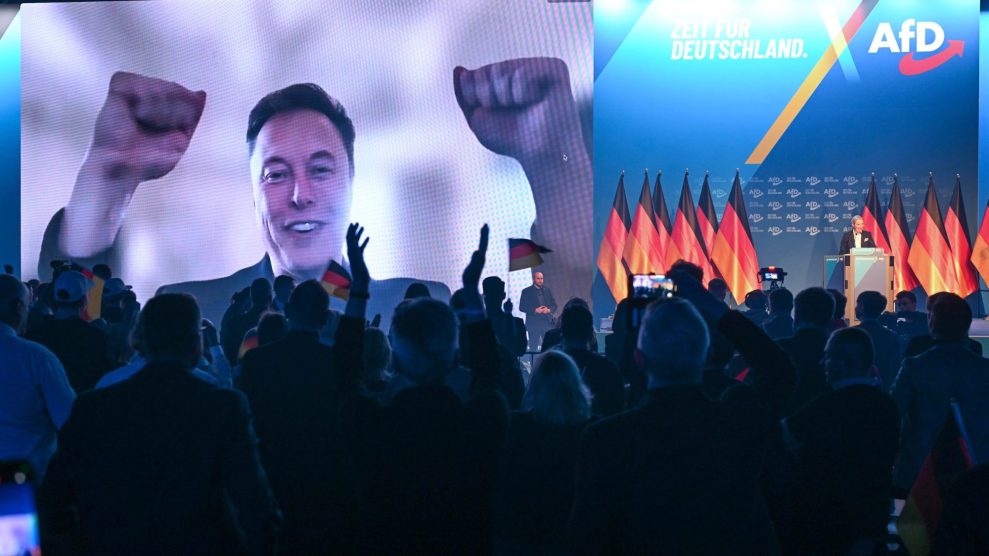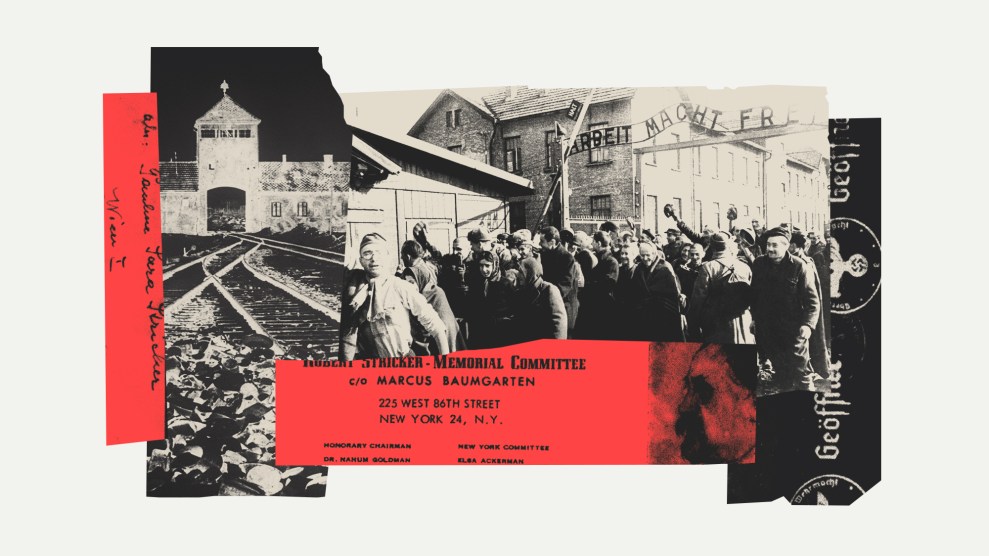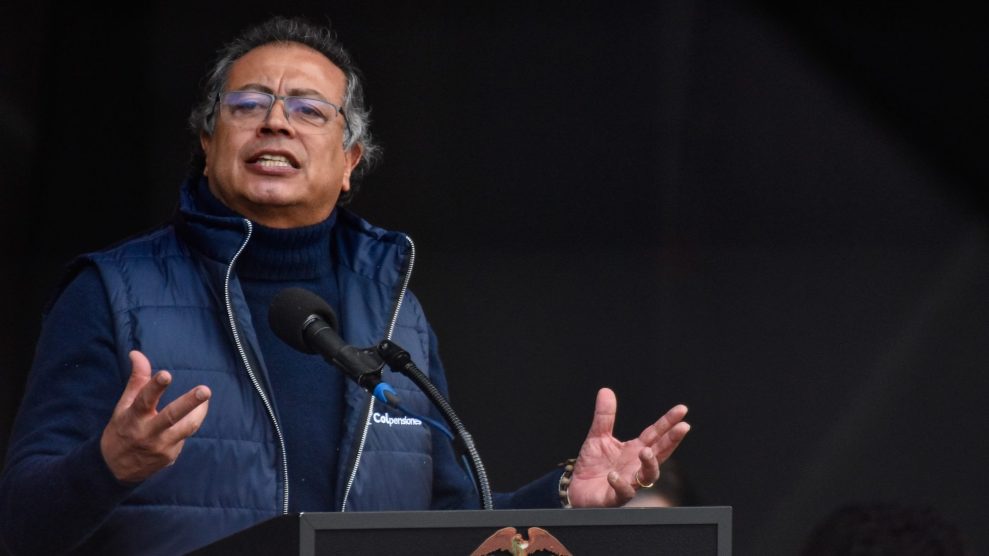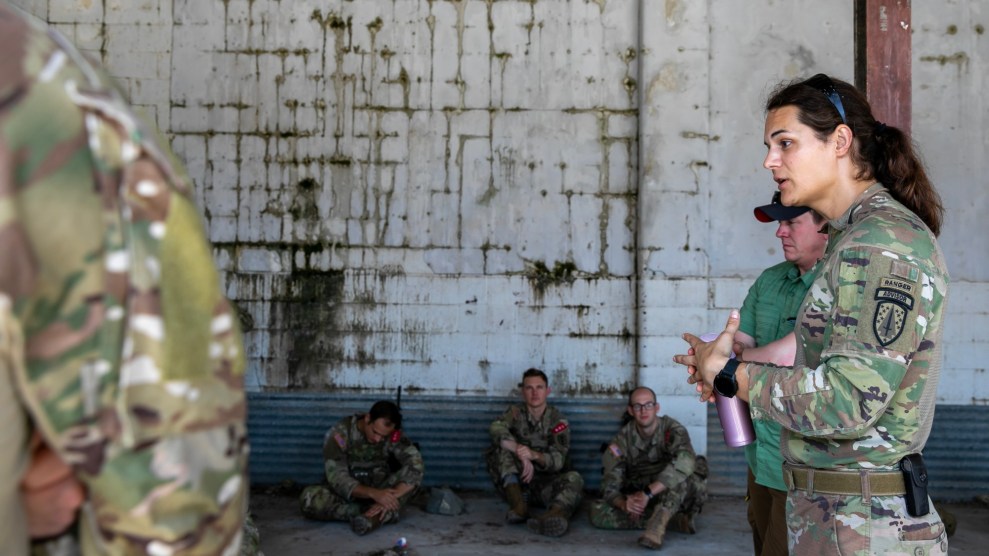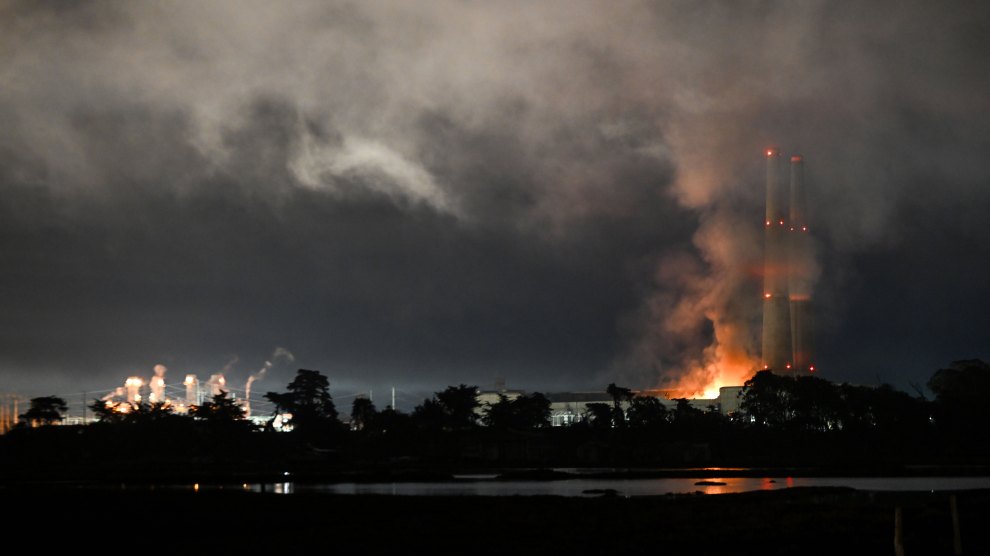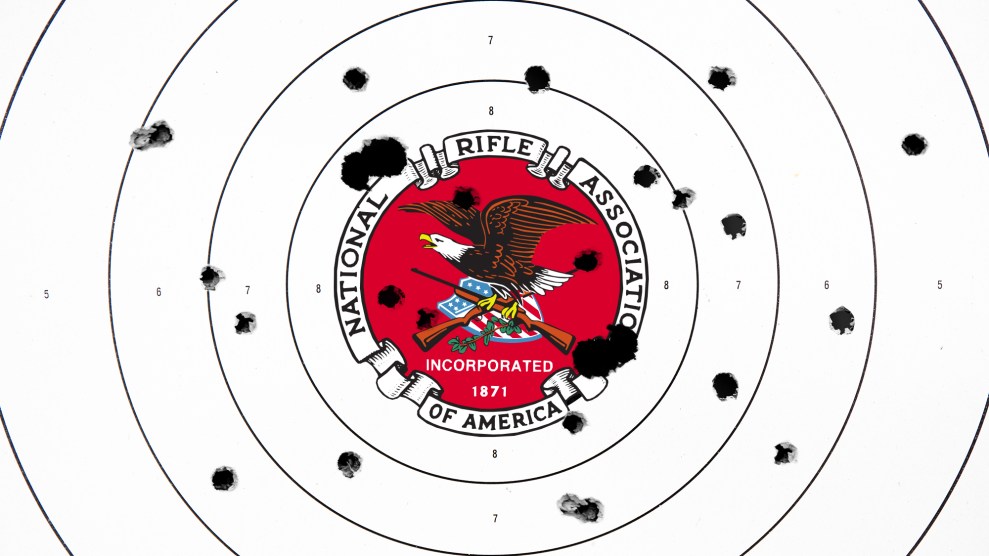
Mother Jones illustration; Getty, Wikipedia
On a frigid Martin Luther King Jr. Day earlier this year, Philip Van Cleave brought out the big guns to Richmond. As he stood on the steps of the Virginia State Capitol, Van Cleave—a 68-year-old balding and mustachioed software programmer—delivered a stern warning to the Democrats who had recently gained control of the state government: “We’re here today to remind Governor [Ralph] Northam and the general assembly that the last election was not a referendum on gun control.” In front of him, an ocean of pro-gun protesters whooped in solidarity. Nearly all were armed, many gripping AR-15-style rifles or other assault weapons. A good number were decked out in paramilitary outfits and tactical gear. Confederate and Gadsden flags waved high and wide.
It was a scene that once would have been credited to the National Rifle Association—the nation’s oldest gun rights group, which, over the past several decades, has inflamed and radicalized a broad coalition of conservative gun owners through alarmist messaging, especially during the Obama administration, and cemented itself as a formidable political force. But the NRA has since dwindled in power, and the rally was the work of Van Cleave’s Virginia Citizens Defense League, a no-compromise, far-right gun rights group that he once boasted was “proud” to have been labeled an “extremist” organization.
Over the past 19 years, VCDL’s Lobby Day protests in Richmond—an annual event on MLK Day when special interest groups, predominantly ones with conservative ties, advocate to the General Assembly—were relatively mild affairs, with about 600 to 800 attendees. But this year it attracted more than 20,000, and the days leading up to the protest put the state on edge. The FBI arrested members of the neo-Nazi group the Base, who had allegedly stockpiled firearms and ammunition, discussed plans to recruit members at the rally to help kickstart a race war, and talked about committing acts of violence against people of color. Northam declared a state of emergency to ban weapons on the grounds of the state capitol building, but the crowd was so large that most armed attendees couldn’t even fit in the area, instead spilling into the side streets of downtown Richmond. Alex Jones, the notorious conspiracy theorist and Infowars founder, drove around the streets in an armored vehicle screaming through a bullhorn, “If they try to take our firearms, 1776 will commence again!”
The rally was a bellwether: the sudden downfall of the nation’s most powerful gun group and the rise of more radical pro-gun organizations and militias seeking to take its place. Since 2016, the NRA has seen a steady decline in its ranks. Meanwhile, there’s been a boon in membership for more extreme groups like the VCDL and the Second Amendment Foundation, which recently filed a number of lawsuits challenging state gun control laws, and the National Association for Gun Rights, which paints itself as a more conservative alternative to the NRA.
There’s no doubt a void to be filled by the NRA, but it’s unclear what groups will dominate. “We’ve got 100 million gun owners in this country,” says Joshua Powell, the NRA director’s former chief of staff. “Whether it’s the NRA or some other group, somebody’s going to have to fill those shoes.” Powell was fired from the NRA last year amid allegations of sexual harassment, and he’s since published a memoir detailing the behind-the-scenes corruption within the organization. “It is important to have an institution that represents Second Amendment supporters, gun owners,” Powell adds. “This is part and parcel to the fabric of our country. The Second Amendment is not going anywhere.” Van Cleave is also confident that there will be a group, or a splintered coalition of smaller groups, to step into the NRA’s shoes. “There’s not going to be a void there,” he says. “Somebody’s going to fill that.”
The NRA’s downward spiral started with its greatest accomplishment: spending $54 million to help elect Donald Trump in 2016. But the first signs of financial trouble emerged the following year, which the NRA ended with a $1.1 million shortfall thanks to shrinking member revenue, probably because it no longer had Barack Obama as a liberal boogeyman to fundraise off of, as well as an increase in spending. The next year, 2018, saw an increase in revenue from membership dues, but the nonprofit again spent more money than it brought in, digging an even deeper hole of $10.8 million in the red, as its debts piled up.
The dam broke for the NRA in 2019 when, just before its annual meeting and convention in Indianapolis, the New Yorker and the Trace published a bombshell report detailing allegations of self-dealing among its top vendors, gratuitous spending, sweetheart deals, and other financial improprieties among the group’s leadership—chiefly its executive vice president, Wayne LaPierre, who has led the organization since 1991. At the meeting, then-NRA President Oliver North unsuccessfully tried to oust LaPierre and demanded his resignation.
LaPierre survived the uprising, as a majority of the NRA’s 76-member board backed him unanimously and North resigned. But the damage was done. An anonymous source leaked financial documents that exposed years of corruption, including a damning letter that North penned. In a court filing from later last year North’s lawyers said that “LaPierre — demonstrating his total dictatorial control over the NRA…stopped all of North’s inquiries and prevented others at the NRA from looking into the concerns that North raised.”
Days after North’s attempted coup against LaPierre, New York Attorney General Letitia James opened an investigation into the NRA’s tax-exempt status. After spending a year investigating, in August her office filed a massive lawsuit against the NRA, accusing it of widespread corruption and seeking to dissolve the organization in its entirety. “The NRA’s influence has been so powerful that the organization went unchecked for decades while top executives funneled millions into their own pockets,” James said in statement announcing the lawsuit. “The NRA is fraught with fraud and abuse, which is why…we seek to dissolve the NRA, because no organization is above the law.” The lawsuit has since been tied up in a number of challenges by the NRA’s legal team. After years of denying allegations of financial misconduct, the NRA finally admitted in its most recent tax filing that the organization only recently became aware “of a significant diversion of its assets” between LaPierre and five former executives.
The NRA has always been notoriously cagey about its membership numbers, but its tax returns and other financial documents offer a glimpse into the dire situation. An audited financial statement shows that revenue from member dues dropped from $170 million in 2018 to $113 million last year—a 34 percent decline— marking the lowest annual membership revenue figure that the NRA has posted since 2012, which is especially troubling considering that the cost of membership dues has sharply increased in that time—at least twice in the last four years alone. (The NRA did not respond for a request for clarification on membership numbers and the decline in revenue from member dues.) That drop in revenue, along with the millions of dollars it has tied up to fight the New York attorney general’s lawsuit and other litigation, meant a far smaller war chest for the 2020 election. This time around, the NRA spent only $24 million on federal elections—less than half of what it did in 2016 and barely more than the combined $22.1 million spent by two of the nation’s largest gun reform organizations, Everytown for Gun Safety and Giffords. Meanwhile, the Gun Owners of America spent $900,000 in the 2020 election cycle, 14 times more than in 2016.
“That’s a huge decrease in political spending,” Adam Winkler, a constitutional law professor and gun policy expert at UCLA’s School of Law, says of the NRA’s involvement in the 2020 election. “Especially at a time when the gun control side is becoming more active, more engaged, putting more money into elections, and doing better get-out-the-vote mobilization efforts than ever before.” All the while, more and more NRA members became disappointed and disillusioned with the organization. “They’ve certainly lost members over this,” says Van Cleave, who claims that his group’s membership more than quadrupled in the six weeks following its 2020 Lobby Day rally, growing from about 8,000 to more than 35,000. Many of the new members of his group, he says, had quit the NRA. “I see a lot of disappointment,” he adds. “The way a lot of the money is being used. That’s the concern.”
The Virginia Citizens Defense League came into existence in 1994, just as congressional Democrats pushed through a pair of gun safety bills—including a decade-long ban on assault weapons—that sparked the modern gun control debate. Paul Moog formed the group to fight gun safety legislation not on a national level, but locally in Virginia. Originally called the Northern Virginia Citizens Defense League, the group’s first order of business was to pressure state lawmakers to change the state’s concealed carry laws from its “may issue” legal status—meaning that the state may issue a concealed carry permit only to people who can prove they have a good reason—to “shall issue,” granting anyone eligible to own a firearm to also obtain a concealed carry permit.
Building on the early success, Moog soon dropped the “Northern” from VCDL’s title and set his sights on ensuring that the whole state was as gun-friendly as it could possibly be. To do so, the group established a playbook of lobbying lawmakers—much like the NRA—coupled with public protests meant to intimidate any push for tightening Virginia’s gun laws. In 1998, VCDL members protested a Northern Virginia church’s gift-for-guns program, which encouraged people to surrender their unwanted firearms in exchange for gift certificates to local businesses. In 2002, the group led a boycott against the Valley View Mall in Roanoke over its ban of firearms in the mall. And in 2004, after a slew of gun control bills failed to make it out of the state’s general assembly, the VCDL encourage firearm owners to turn up at restaurants and shopping centers with their sidearm strapped to their hip in celebration—in turn intimidating some clientele.
In 2001, Van Cleave became the group’s president and, one year later, members staged their first Lobby Day protest. Under his leadership, the VCDL has expanded its national profile, showing an eagerness to go on national news programs to defend his extremist views on the Second Amendment—especially in the wake of mass shootings. After the Sandy Hook massacre in 2012, Van Cleave gleefully defended the semiautomatic military-style rifle used by the shooter, Adam Lanza, to the Washington Post. “Guns are fun, and some of them are much more cool than others,” he said. “It’s just like we have television sets that look cool, and others are much more boxy.” He has also criticized the NRA for not going far enough in their comments calling for armed guards in schools. “If you have got a permit, if you’re carrying everywhere else you go…a school is no different,” Van Cleave told WWBT, Richmond’s NBC affiliate.
But Van Cleave’s most notable brush with public notoriety is also his most embarrassing. In 2018, he was duped by notorious prankster Sacha Baron Cohen for his Showtime series “Who Is America?” in a segment where he films a faux-PSA for a gun-training program for kids, “KinderGuardians.” Despite the embarrassment (which he attempted to distance himself from by claiming he knew he was being set up but went along in an attempt to protect other gun advocates from similar ploys), Van Cleave and the VCDL have managed to greatly broaden their coalition within Virginia, acting as both a blueprint for local grassroots gun rights groups in other states and as fodder for national ones seeking to capitalize on the NRA’s decline.
Since the Lobby Day rally, a number of militias have formed throughout Virginia, something that Van Cleave says the VCDL wasn’t involved in organizing but welcomes. But his group has been busy this year: the VCDL fought Northam’s actions to slow the spread of the coronavirus, including a successful legal effort in April to overturn part of the governor’s executive order that classified shooting ranges among the businesses forced to close as the state went into lockdown. The VCDL has also been heavily involved in the growing number of towns and municipalities in the state declaring themselves Second Amendment sanctuaries and vowing not to enforce any new gun control laws passed at the state and county level. Through VCDL’s email alert system, which Van Cleave says has tens of thousands of subscribers, they are able to send an SOS to its members whenever gun control legislation is on the table anywhere in the state, mobilizing members to voice opposition to any such measures in public comment forums. “We don’t let these localities take our basic civil rights and do with them what they please,” Van Cleave told a local Virginia newspaper in July. “When it comes to guns, that’s when the rules go out the window…we’re not going to let them get away with it.”
Several groups have already ramped up their operations over the past year, such as Gun Owners of America, a national group that former Texas Rep. Ron Paul once called “the only no-compromise gun lobby in Washington.” Van Cleave says the VCDL has “been working quite a bit with” Gun Owners of America on both state and national issues. “I think what’s going to happen is as the NRA ends up being pretty crippled for a while, there are other organizations that are going to step forward,” he says. “There’s not going to be a void there, somebody’s going to fill that.”
As the coronavirus sent much of the country into lockdown this spring, more new armed groups emerged in protest. Members of the Michigan Liberty Militia stormed the state’s capitol building in protest of the “tyranny” that Democratic Gov. Gretchen Whitmer was imposing with her strict stay-at-home orders. As unrest in the wake of George Floyd’s murder spread across the country, so too did armed militia groups, from Portland to Wisconsin, Texas, and Virginia, where authorities claim that the antigovernment extremist group known as the “boogaloo boys”—whose rise this year started at the Lobby Day rally in Richmond—stoked violent confrontations between police and Black Lives Matter protesters. In mid-October, the FBI announced that members of an extremist militia group had plotted to kidnap Gov. Whitmer, as well as take over the state’s capitol building, where they would hold televised executions of public officials. The group also discussed “taking” Northam, Virginia’s Democratic governor, according to the FBI. But Van Cleave dismisses any connection between VCDL’s Lobby Day protest and the rise of violence from extremist militia groups, calling it overblown lies from the media. “I’m very skeptical of a lot of that,” he says.
Still, as groups vie to fill the NRA’s void, extremist gun violence is increasing in ever more concerning ways. Two armed men from Virginia were arrested outside of the Philadelphia Convention Center on November 5 after police received a tip about plans to raid a “truckload of fake ballots.” One of the men, Joshua Macias, co-founded the group Vets for Trump and had attended VCDL’s Lobby Day rally in January, according to a review of his Twitter account. In a video taken during the rally, Macias can be seen, with a bullhorn in hand, firing up a crowd of hundreds on a downtown Richmond side street: “There are veterans out here…who made an oath to defend this constitution against foreign and domestic enemies!”
In the aftermath of the election, as Trump refused to concede and peddled conspiracy theories about election fraud, thousands of his supporters—including violent extremist groups like the Proud Boys—marched in DC to protest the results. Though DC law forbids carrying firearms in most public places, including at public demonstrations, the Oath Keepers, an extremist militia group, posted a note on its website to supporters saying that “our men will be standing by, awaiting the President’s orders to call us up as the militia, which would override D.C.’s ridiculous anti-gun laws.” At least four people were arrested on gun charges at the rally.
Not all gun owners are flocking to these far-right groups. Other gun groups like the Socialist Rifle Association and the National African American Gun Association have also seen membership increase, though theirs is much smaller than their ultra-right counterparts. And in October, Giffords, the gun safety group co-founded by former Arizona Rep. Gabby Giffords (D), launched a new national firearms group for gun owners that it hopes can take the NRA’s mantle while also pushing for gun control measures.
It would be convenient to link the rise of extremist gun groups this year to the NRA’s downfall: At a time when gun control groups are more impactful than they’ve ever been—spending millions of dollars to successfully boost political candidates running on a gun control platform—their biggest foe is down and out, leaving gun owners across the country feeling powerless. But Winkler doesn’t think the narrative tracks. He explains that the rise in militia activity and armed protesters this year “seems to be the natural growth of something that started about 10 to 12 years ago” with the tea party movement when guns became a symbol of protest. “I don’t think the vast majority of people who bring guns to a protest are planning on starting a firefight,” he says. “They’re not planning on starting a war. They’re doing it symbolically for protest.” Still, Winkler worries that it can go awry, especially given the spate of right-wing violence from extremist militias at protests over the summer. “They’re suddenly shifting to self-defense,” he says, “the moment they see someone or something happening that they feel threatened by.”
Van Cleave sees his group’s Lobby Day protest and continued advocacy for gun rights not so much as a protest, but as a battle. That’s especially true in a Joe Biden–Kamala Harris administration, which Van Cleave says has “basically declared war on the Second Amendment.” His group was planning another massive Lobby Day protest next month, but that went awry when gun control groups got permits for the space where VCDL typically holds its event. In retaliation, VCDL sent a message to members with plans for a caravan rally similar to the Trump rallies that took place across the country before the election. “VCDL is going to do that…but on steroids!” the email stated. Beyond Lobby Day, Van Cleave hints at other events and strategies to fight any gun control laws that the new administration may try to pass, whether through litigation or on the streets. “Our job is to protect that [Second Amendment] right by whatever means is necessary.”

